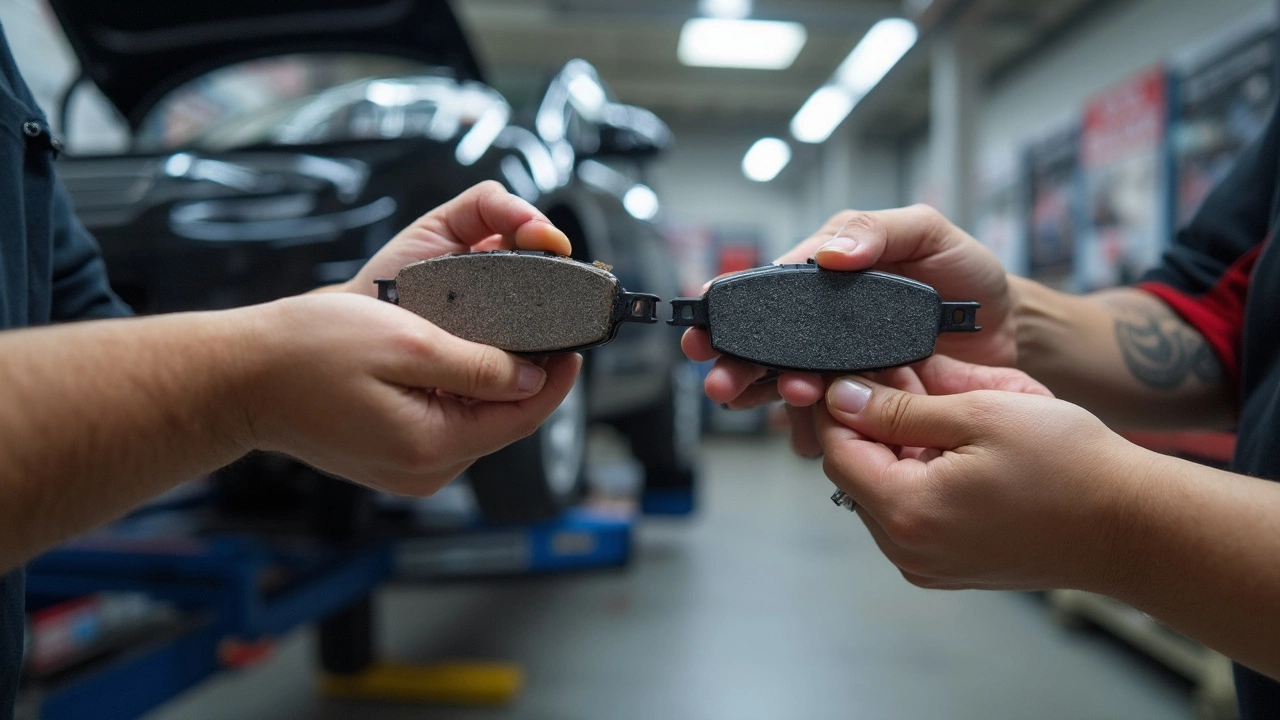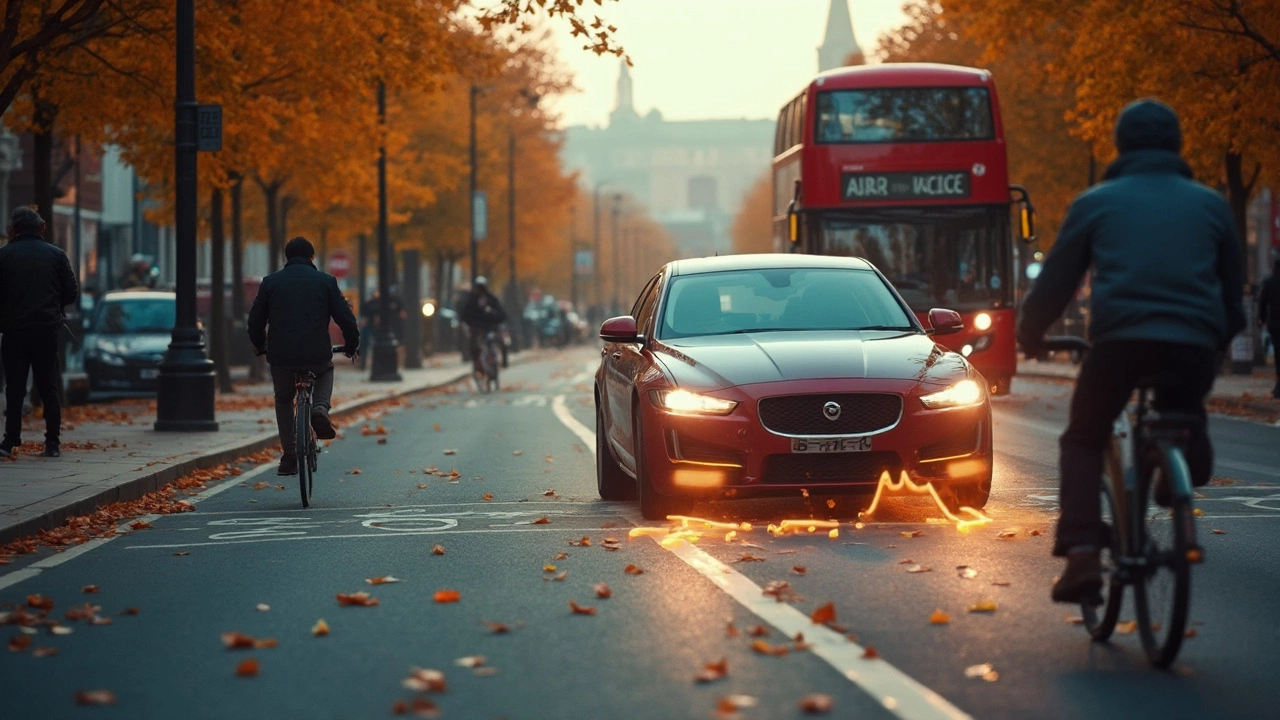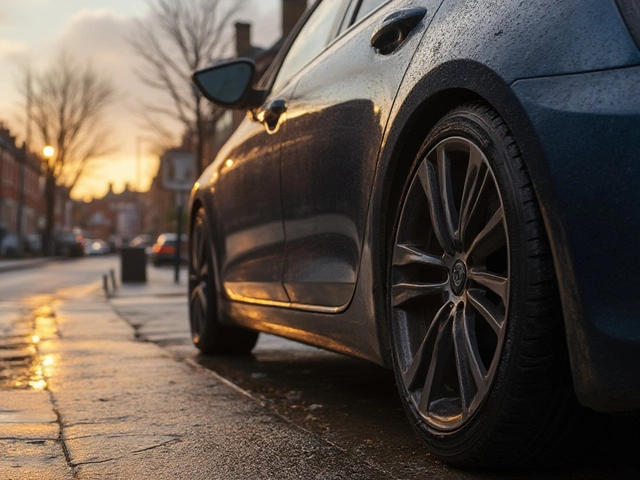Most people guess wrong about which brakes wear out first. It’s almost always the front brake pads that go before the rear ones. Here’s why: on most cars, when you hit the brakes, the weight shifts forward. That means the front brakes do about 60% to 75% of the work stopping your car. So, they just wear down faster, plain and simple.
If you mostly drive in the city, your front pads are really feeling the heat. Stop-and-go traffic, lots of lights, and sudden stops all put extra pressure on the front brakes. Highway driving? That’s a little easier on them, but the front still leads when it comes to wearing out first.
Knowing this can actually save you money and headaches. Instead of waiting for screeching sounds or spongy pedals, keeping an eye on those front pads is just common sense maintenance. And, if your mechanic tells you the front need changing but the rear don't, they're not just looking for extra cash—it's just how your car's made.
- Why Front Brakes Wear Out First
- What Affects Brake Pad Wear
- Signs Your Brakes Need Attention
- How to Extend Brake Life
- Common Myths About Brake Pads
Why Front Brakes Wear Out First
It comes down to physics and the job each brake does. When you step on the brake pedal, most of your car's weight shifts forward. The front brakes end up handling the bulk of stopping power—sometimes up to 75% of it. The rear brakes do pitch in, but they’re really just playing backup in most situations.
Think about a bike for a second. When you stop hard, most of your weight moves over the front wheel. That’s kind of what happens with cars too, just with way more metal and speed involved. That forward weight transfer means your front brake pads face more friction and heat than the ones in the back.
There’s also the way modern braking systems are built. Most cars today have bigger brake rotors and pads up front, and these are designed to wear out faster than the rear ones. That sounds strange, but it actually helps keep your car stable and prevents skidding during sudden stops.
| Brake Location | Average Wear Rate | Replacement Interval (miles) |
|---|---|---|
| Front | High | 30,000-40,000 |
| Rear | Low | 50,000-60,000 |
Another thing: on front-wheel drive vehicles (which is most cars these days), not only are the front brakes doing more work, but they’re sharing axle space with all the stuff that makes your car actually move. That extra job just speeds up the wear and tear.
If you ever notice your front brake pads wearing out before the back ones, you’re not alone. It’s just how things work—no mystery, nothing strange. And knowing this gives you a leg up on keeping your brake pads in good shape.
What Affects Brake Pad Wear
Lots of everyday things can chew up your brake pads faster than you might think. First up: the way you drive. If you're heavy on the brakes, tailgate, or brake at the last second, you’ll burn through pads much quicker than someone who coasts to a stop. Smooth, gentle braking goes a long way in making them last.
Driving location also matters. City drivers with tons of traffic lights and stop signs are much harder on their front brakes than someone cruising country roads. All that stop-and-go adds up fast.
Another thing? The weight of your car. Heavy vehicles or ones loaded down with stuff (think big SUVs, work vans, or hauling trailers) put more pressure on the brake pads. More weight means more force needed to stop, which means more wear.
Your brake pad material matters, too. Ceramic pads are pretty common and last longer, but they cost more. Organic pads are quieter but wear out sooner. Semi-metallic is kind of a middle ground, but they often wear out rotors quicker.
- Driving style: Aggressive braking = faster pad wear
- Type of brake pad: Ceramic, organic, or semi-metallic all wear differently
- Car weight: Heavier cars eat pads faster
- Where you drive: City = faster wear, highway = slower
- Even your climate: Lots of rain or salty roads can add to the problem
Here’s a quick table showing how different pad types stack up:
| Pad Type | Average Lifespan (Miles) | Best For |
|---|---|---|
| Ceramic | 30,000 - 70,000 | Daily driving, quieter operation |
| Semi-metallic | 20,000 - 50,000 | Heavy-duty, cold climates |
| Organic | 15,000 - 30,000 | Light, everyday use |
Keep all this in mind, and you’ll spot trouble sooner—and maybe even make those brake pads last a bit longer.

Signs Your Brakes Need Attention
Not sure when your brake pads need changing? Your car actually gives you plenty of hints—if you’re paying attention. Knowing these signs can help you keep your car safe and avoid pricier repairs later on.
The most obvious sign is noise. When you hear a squealing or screeching sound every time you hit the brakes, that’s your first red flag. It usually means your front brakes are low and the wear indicator is doing its job. Ignoring this gets expensive, fast—if you hear grinding, your pads are probably gone and the metal is digging right into the rotors.
You might also notice shakiness or vibrations when braking. If your steering wheel wobbles or the car feels like it’s pulsing under your foot, your rotors could be warped. Sometimes, uneven brake wear or cheap pads cause this too.
Another common giveaway is when your car pulls to one side. If you hit the brakes and your ride swerves left or right, it usually means one side’s brake pads are more worn—or a caliper is stuck. Don’t ignore it, or you’ll wear down your pads and maybe even your tires way faster.
- Dashboard light: If your car has a brake warning light, don’t hope it’ll just go away. Check it out right away.
- Longer stopping distances: If you need to press the pedal harder or your car takes longer to stop, those brake pads are likely thinning out.
- Low brake pedal: If your pedal feels squishy or sinks further than usual, air or moisture might be in the line, or your pads are worn out.
- Visible thin pads: Look through your wheel spokes with your flashlight. See less than 1/4 inch of pad? Time to swap them out soon.
| Sign | Possible Cause |
|---|---|
| Squealing noise | Wear indicator or thin brake pads |
| Grinding sound | Pads completely worn, metal-on-metal |
| Vibrating when braking | Warped rotors or uneven pad wear |
| Pulling to one side | Uneven wear or stuck caliper |
The real trick here is not to wait for these symptoms to get really bad. A quick look and a listen every few thousand miles saves you from bigger, more stressful fixes later. Trust your gut—if something feels different about your brakes, it’s probably time for a check.
How to Extend Brake Life
Want your brake pads to last longer? It’s easier than you think. Most folks replace the front pads first, but you can stretch the time between services if you drive smart. Here’s what actually works:
- Coast before braking. Ease off the gas early when you see a red light or slow traffic. This way, your car slows down on its own, and your front brakes get a break too.
- Don’t ride the brakes downhill. If you press the brakes the whole way down a hill, the pads wear out fast. Instead, shift into a lower gear and tap the brakes now and then.
- Keep your car light. Hauling around a bunch of stuff? More weight means your brake pads have to work harder each time you stop. Dump what you don’t need.
- Stay smooth. Hard, sudden stops chew up front brake pads. Try to brake gently and steadily instead.
- Get regular checks. A quick check during oil changes or tire rotations can catch worn pads before they do damage to your rotors.
How much difference do these tips make? Check out the kind of mileage you might get if you take it easy versus if you’re always slamming the brakes:
| Driving Style | Front Pad Life (Miles) | Rear Pad Life (Miles) |
|---|---|---|
| Gentle, highway driving | 40,000–60,000 | 60,000–80,000 |
| Stop-and-go, city driving | 20,000–35,000 | 35,000–50,000 |
Finally, don’t ignore little squeaks or grinding noises. That sound means your brake pads are begging for help. Fixing them early is way cheaper than replacing rotors or calipers later.

Common Myths About Brake Pads
There’s a lot of junk info online about brake pads. Sometimes, even car forums repeat these myths so much, people take them as truth. Let’s set the record straight on the most common ones.
- “Brake pads should always wear evenly front and rear.” That’s just not true. Like we said before, your front brake pads do most of the stopping, so they typically wear out first. If you’re replacing your front pads way more often than your rears, your car’s working the way it should.
- “All brake pads are basically the same.” Nope! There are big differences—ceramic vs. semi-metallic vs. organic pads. Each has pros and cons for noise, dust, price, and how hard they hit your rotors. Ask your mechanic for what fits your driving habits.
- “Thicker brake pads mean better brakes.” Thickness matters because you don’t want pads that are too worn, but the material, not just thickness, makes the real difference. Cheap, thick pads can still be lousy at stopping your car.
- “Brakes only wear when you’re braking.” This one’s half-true. Most wear does happen when you brake, but riding the brakes or even a sticky caliper can cause constant rubbing and extra wear.
- “You’ll always hear a squeal when brakes are worn.” Not always! Worn pads can go quiet until it’s almost too late, especially with some aftermarket brands. Some pads come with wear indicators that squeal, but not all of them.
Here’s a quick breakdown of popular brake pad materials and their main features:
| Type | Pros | Cons |
|---|---|---|
| Ceramic | Quiet, low-dust, long-lasting | Higher cost, less bite in extreme cold |
| Semi-Metallic | Good bite, affordable, decent wear | Noisier, more dust |
| Organic | Budget-friendly, quiet | Wear quickly, can fade with hard use |
Experts agree—listen to how your brakes feel and sound, but don’t fall for myths. The folks at Car and Driver hit the nail on the head:
"Regular brake inspections let you catch worn pads before they cause real damage, no matter what myths you’ve read online."
Stick to facts, check your brake pads when you rotate tires, and don’t let common myths steer you wrong.


